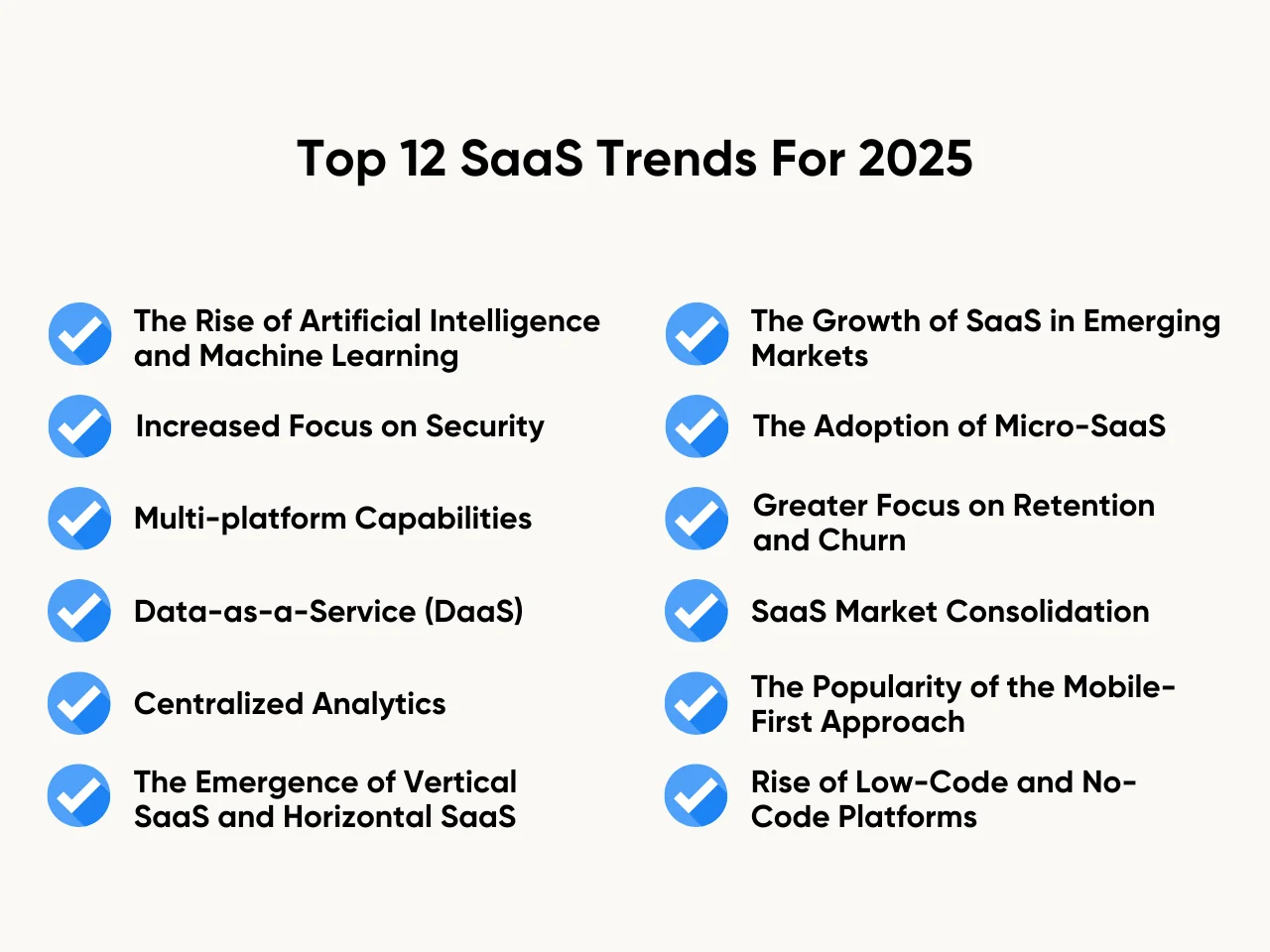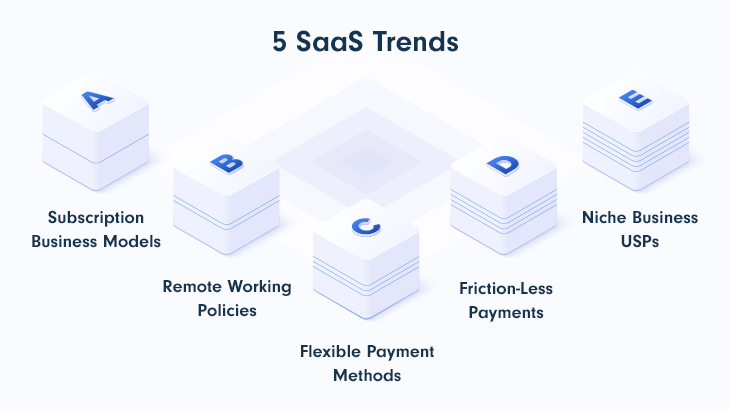As we venture into 2025, the Software as a Service (SaaS) industry continues to evolve at a breakneck pace. For tech enthusiasts, entrepreneurs, and IT decision-makers, staying ahead of the curve is not just beneficial—it’s essential. This comprehensive guide delves into the latest SaaS trends, offering insights that could prove pivotal for your business strategy.
Key SaaS Trends Shaping the Industry in 2025
Customer Experience: The New Battleground
In 2025, customer experience has become the primary differentiator in the SaaS market. Companies are leveraging advanced technologies to create personalized, intuitive interfaces that adapt to individual user preferences.
For instance, Salesforce’s Einstein AI now offers predictive customer service, anticipating issues before they arise. This proactive approach has reduced customer churn rates by an impressive 25% for early adopters.
Moreover, companies are increasingly adopting voice-activated interfaces. Microsoft’s integration of GPT-4 into its Office suite allows users to draft emails, create presentations, and analyze data using natural language commands, significantly enhancing productivity and user satisfaction.
Seamless Integration: The New Normal
Gone are the days when SaaS solutions operated in silos. In 2025, seamless integration is not just expected—it’s demanded. SaaS providers are focusing on creating ecosystems rather than standalone products.
Zapier, a leader in automation, has expanded its capabilities to include AI-powered workflow suggestions. This feature analyzes user behavior and recommends efficient automation sequences, saving businesses countless hours in setup and optimization.
Additionally, major players like Google and Amazon have opened their APIs further, allowing for deeper integrations. This move has spawned a new generation of « super apps » that combine functionalities from multiple SaaS providers into unified interfaces.
The Rise of Vertical SaaS
While horizontal SaaS solutions continue to dominate, vertical SaaS is experiencing a renaissance. These industry-specific solutions are gaining traction due to their ability to address unique challenges faced by particular sectors.
In healthcare, companies like Athenahealth have revolutionized electronic health records by incorporating AI-driven diagnostics and personalized treatment recommendations. Their platform has reduced misdiagnoses by 18% in pilot programs.
The financial sector has seen the emergence of RegTech SaaS solutions. Firms like Comply Advantage use machine learning to navigate the complex world of financial regulations, saving banks millions in potential fines and reputation damage.
The Evolving Role of AI and Machine Learning in SaaS
From Predictive to Prescriptive Analytics
AI and machine learning have moved beyond simple predictive analytics. In 2025, SaaS solutions are offering prescriptive insights, not just telling you what might happen, but suggesting specific actions to optimize outcomes.
For example, Tableau’s latest release incorporates a « Decision Engine » that doesn’t just visualize data but recommends concrete business decisions based on complex scenario analyses. Early adopters report a 30% improvement in decision-making efficiency.
Moreover, these AI systems are becoming more explainable. IBM’s Watson AI now provides detailed rationales for its suggestions, addressing the long-standing « black box » concern in AI decision-making.
AI-Driven Development and Testing
AI is not just a feature in SaaS products; it’s revolutionizing how they’re built. AI-assisted coding platforms like GitHub Copilot have evolved to suggest entire architectural patterns, dramatically speeding up development cycles.
In testing, AI-powered tools can now generate test cases based on user behavior patterns, ensuring more comprehensive coverage. This has led to a 40% reduction in post-release bugs for companies adopting these technologies.
Ethical AI: A New Frontier
As AI becomes more pervasive, ethical considerations are taking center stage. SaaS providers are now required to demonstrate the fairness and transparency of their AI algorithms.
Google Cloud has introduced an « AI Ethics Board » feature for its enterprise customers, allowing companies to set ethical guidelines for AI usage and monitor compliance in real-time.

Financial Models in SaaS: Adapting to Market Demands
The Evolution of Freemium
Freemium models have become more sophisticated in 2025. Instead of fixed free tiers, companies are offering dynamic freemium experiences tailored to individual user behavior.
Dropbox, for instance, now uses AI to analyze usage patterns and offer personalized upgrade suggestions, resulting in a 35% increase in conversion rates from free to paid users.
Some companies are experimenting with « reverse freemium » models, where advanced features are free for a limited time, hooking users on premium experiences before transitioning them to paid plans.
Usage-Based Pricing Gains Ground
As businesses demand more flexibility, usage-based pricing models are becoming increasingly popular. This shift allows companies to align their SaaS expenses directly with the value they derive.
Amazon Web Services has refined its pricing model to charge not just for compute resources but for specific API calls, allowing for more granular cost control. This model has been particularly appealing to startups and SMEs with fluctuating demands.
Interestingly, some SaaS providers are offering « negative pricing » for certain actions that benefit the ecosystem. For example, Shopify provides credits to stores that contribute to its app marketplace, creating a virtuous cycle of development and usage.
SaaS and the Future of Remote Work
Virtual Reality Collaboration Platforms
As remote work becomes the norm, SaaS providers are pushing the boundaries of virtual collaboration. Virtual Reality (VR) meeting spaces are no longer novelties but essential tools for distributed teams.
Microsoft’s Mesh for Teams now supports fully immersive VR environments, complete with spatial audio and haptic feedback. Early adopters report a 40% increase in engagement during virtual meetings compared to traditional video calls.
These platforms are not just for meetings; they’re being used for virtual product demos, training sessions, and even social events, fostering a sense of presence and community among remote teams.
Advanced Employee Experience Platforms (EXP)
Employee Experience Platforms have evolved into comprehensive ecosystems that manage every aspect of an employee’s digital work life. These platforms now incorporate elements of gamification, mental health support, and personalized learning paths.
Workday’s latest EXP offering includes an AI career coach that suggests skill development opportunities based on an employee’s career goals and company needs. This feature has led to a 25% increase in internal promotions for companies using the platform.
Moreover, these platforms are becoming central hubs for company culture in distributed teams. They facilitate virtual water cooler conversations, celebrate milestones, and even organize cross-departmental virtual events.
Sustainability in SaaS: More Than Just a Buzzword
Carbon-Aware Computing
Sustainability has moved from a nice-to-have to a must-have feature in SaaS offerings. Companies are not just focusing on reducing their carbon footprint but are offering tools to help their customers do the same.
Google Cloud now provides a « Carbon Footprint » dashboard that allows companies to monitor and optimize the environmental impact of their cloud usage in real-time. Some companies have reported up to 60% reduction in cloud-related emissions after implementing these tools.
Interestingly, some SaaS providers are experimenting with « carbon negative » features. Salesforce, for example, plants trees based on the API calls made by its customers, effectively offsetting more carbon than its services produce.
Circular Economy in SaaS
The concept of circular economy is making its way into SaaS business models. Companies are looking at ways to reuse and recycle digital resources to minimize waste.
Adobe’s Creative Cloud now includes a « Digital Asset Recycling » feature that suggests ways to repurpose unused design elements, reducing digital clutter and inspiring creativity. This approach has led to a 20% reduction in new asset creation, saving both time and computational resources.
For more on sustainable practices in tech, this YouTube video by Tech for Good provides excellent insights.

Security and Compliance: Cornerstones of Modern SaaS
Zero Trust Architecture
In 2025, Zero Trust has become the default security model for SaaS applications. This approach assumes no user or system is trustworthy by default, requiring continuous verification.
Okta’s Identity Cloud now includes « Continuous Adaptive Risk Assessment, » which analyzes user behavior in real-time and adjusts access permissions accordingly. This has reduced security incidents by 75% for early adopters.
Moreover, SaaS providers are offering granular control over data residency and sovereignty, allowing companies to comply with increasingly complex international data regulations.
AI-Powered Threat Detection
AI is not just a potential security risk; it’s become a powerful tool in the security arsenal. SaaS security solutions now employ advanced machine learning algorithms to detect and respond to threats in real-time.
Crowdstrike’s Falcon platform uses AI to analyze billions of events daily, identifying and neutralizing threats before they can cause damage. This proactive approach has reduced the average time to detect and contain a breach from 280 days to just 3 hours.
Interestingly, some companies are using AI to simulate cyber attacks, continuously testing and improving their defenses against evolving threats.
Compliance as a Service
With regulations like GDPR and CCPA becoming more complex, compliance has become a service in itself. SaaS providers are offering automated compliance tools that adapt to changing regulations.
OneTrust’s DataGuidance platform now includes an AI-powered « Regulation Translator » that interprets complex legal texts and suggests specific actions to ensure compliance. This feature has reduced compliance-related costs by 40% for its users.
Some SaaS providers are going a step further, offering « Compliance Guarantees » where they take on the legal responsibility for certain aspects of data protection, providing peace of mind to their customers.
Conclusion: Embracing the Future of SaaS
As we navigate the SaaS landscape of 2025, it’s clear that the industry is not just evolving—it’s revolutionizing the way businesses operate. From AI-driven personalization to sustainable computing practices, the trends we’ve explored offer both challenges and immense opportunities.
To stay competitive, businesses must not only adopt these technologies but also rethink their strategies to fully leverage the potential of modern SaaS solutions. The companies that will thrive are those that view SaaS not just as a tool, but as a strategic partner in their digital transformation journey.
Remember, the key to success in this rapidly changing environment is adaptability. Stay curious, keep learning, and don’t be afraid to experiment with new SaaS solutions that could give your business the edge it needs.
Call to Action
Want to stay ahead of the curve in the SaaS world? Subscribe to our newsletter for weekly insights on the latest trends and technologies. Join our upcoming webinar where industry experts will dive deeper into the future of SaaS and answer your burning questions.
Remember, in the world of SaaS, knowledge isn’t just power—it’s profit. Stay informed, stay ahead, and let SaaS be the wind beneath your business’s wings.
